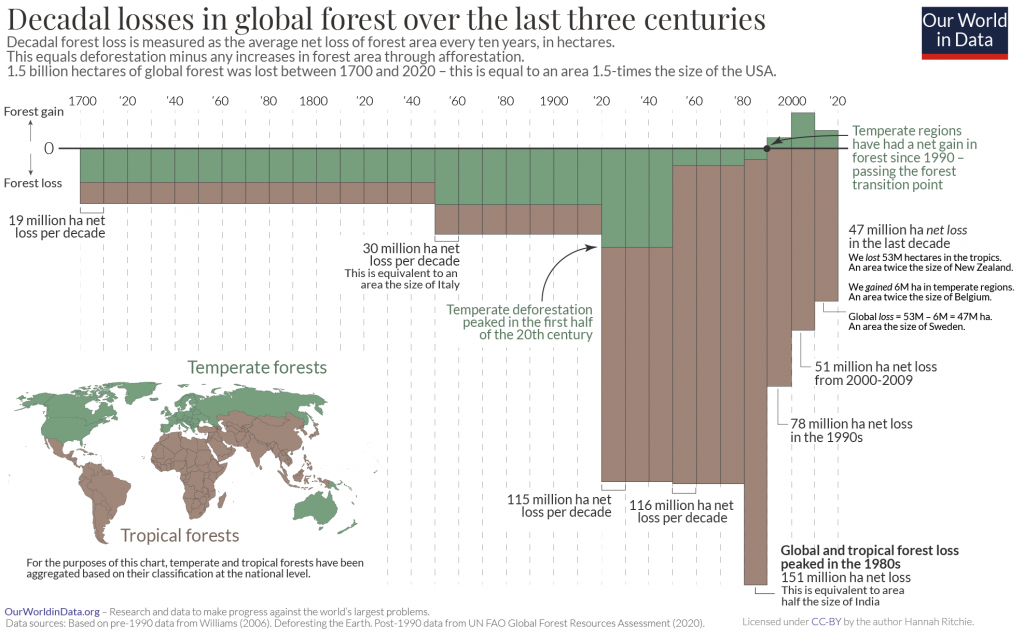How Sustainable Is Beechwood? Here Are the Facts
Impactful Ninja is reader-supported. When you buy through links on our site, we may earn an affiliate commission.
Learn more
Learn more
.
Hey fellow impactful ninja ? You may have noticed that Impactful Ninja is all about providing helpful information to make a positive impact on the world and society. And that we love to link back to where we found all the information for each of our posts. Most of these links are informational-based for you to check out their primary sources with one click. But some of these links are so-called "affiliate links" to products that we recommend. First and foremost, because we believe that they add value to you. For example, when we wrote a post about the environmental impact of long showers, we came across an EPA recommendation to use WaterSense showerheads. So we linked to where you can find them. Or, for many of our posts, we also link to our favorite books on that topic so that you can get a much more holistic overview than one single blog post could provide. And when there is an affiliate program for these products, we sign up for it. For example, as Amazon Associates, we earn from qualifying purchases. First, and most importantly, we still only recommend products that we believe add value for you. When you buy something through one of our affiliate links, we may earn a small commission - but at no additional costs to you. And when you buy something through a link that is not an affiliate link, we won’t receive any commission but we’ll still be happy to have helped you. When we find products that we believe add value to you and the seller has an affiliate program, we sign up for it. When you buy something through one of our affiliate links, we may earn a small commission (at no extra costs to you). And at this point in time, all money is reinvested in sharing the most helpful content with you. This includes all operating costs for running this site and the content creation itself. You may have noticed by the way Impactful Ninja is operated that money is not the driving factor behind it. It is a passion project of mine and I love to share helpful information with you to make a positive impact on the world and society. However, it's a project in that I invest a lot of time and also quite some money. Eventually, my dream is to one day turn this passion project into my full-time job and provide even more helpful information. But that's still a long time to go. Stay impactful,Affiliate Disclosure
Why do we add these product links?
What do these affiliate links mean for you?
What do these affiliate links mean for us?
What does this mean for me personally?
![]()
Beech is increasingly used for more household projects other than firewood. The wood is strong, comparable to oak, and its strength makes it suitable for furniture that withstands a lot of pressure. However, as the beech trees support many animals and birds, cutting down the trees hurts wildlife. So we had to ask: How sustainable is it to buy products made out of beechwood?
Beechwood is sustainable thanks to the carbon sequestration of living beech trees and the low transportation footprint with widely available local sources. The annual volume of beech harvested is currently lower than new growth, making it more sustainable than woods with a decreasing population.
In this article, we’ll walk you through the life-cycle of beechwood used for furniture, flooring and household items. Then, we evaluate its sustainability, potentials, and shortfalls. And in the end, we’ll show you tips for buying sustainable beechwood.
Here’s How Sustainable Beechwood Is
Beechwood is a sustainable material because of the beach trees’ carbon sequestration potential and the carbon offset value at the end of any products made with beechwood.
“Sustainable: The ability to be maintained at a certain rate or level | Avoidance of the depletion of natural resources in order to maintain an ecological balance”
Oxford Dictionary
To better understand the sustainability of beech wood, we assess the life-cycle of projects like flooring or furniture. This life-cycle assessment (LCA) is a method to evaluate the environmental impacts of each stage in a product’s life-cycle, from the making to the recycling. Over the years, companies have strategically used LCA to research and create more sustainable products.
In this article, we’ll use the cradle-to-grave perspective of the LCA, examining the five stages of the life cycle of beechwood. Where it is relevant, we also use data from cradle-to-gate assessments.
| The life-cycle stages of beech wood | Each stage’s sustainability |
| Growing of beech wood | Growing beech trees for timber is sustainable thanks to the carbon sequestration potential and the species’ growing population. |
| Manufacturing of beech wood | Turning beechwood into furniture has a relatively low carbon footprint because wood waste can be recycled fully as by-products or biomass pellets to offset the carbon emissions during harvesting and processing. |
| Transporting of beech wood | Transporting is a relatively carbon-intensive stage in the life cycle of beechwood furniture due to the emissions associated with operating the hauling vehicles that take timber to sawmills and factories, then furniture to stores. As beech trees are distributed widely in the US, a piece of beechwood furniture would have a lower carbon footprint than that made from imported woods. |
| Usage of beech wood | Using beechwood furniture can be sustainable thanks to the carbon capture during the products’ long life. |
| End-of-life of beech wood | The end-of-life stage for beechwood furniture is sustainable when the wood is reused or burned as bioenergy. |
Overall, we can say that beechwood is sustainable. However, the actual environmental impact of a particular product, like a table or a chair, depends on many factors, especially the distance and mode of transportation. Let’s dive deeper into each stage and find out how it can be more sustainable.
How Sustainable Is the Growing of Beechwood
Growing beech trees for timber is sustainable thanks to the carbon sequestration potential and the species’ growing population.
What Type of Wood Is Beechwood and What Does This Mean for Sustainability
Beechwood comes from the slow-growing hardwood tree species of the Fagus genus in the Fagaceae family. The genus has about 10 species, with the two most known as American beech and European beech. These two major species are, however, almost identical to each other. Unless specified otherwise, the beechwood described in this article is of the American beech species.
The average growth rate of beach trees is slow to medium, ranging from 12 inches to 24 inches. Beech trees reach maturity and are ready to be harvested after 80 to 120 years.
How Sustainably Does Beechwood Grow
The carbon sequestration potential and a growing population mean growing and harvesting beech for timber is sustainable.
- Carbon Sequestration: As beech trees grow, they absorb CO2 from the atmosphere while releasing oxygen. They act as a carbon sink during their long lifespan, which averages from 300 to 400 years. This means that they are taking greenhouse gases out of the atmosphere, helping to mitigate the climate crisis. And they can store a lot as they grow up to 130 feet in height and 5 feet in trunk diameter.
- A growing population: The US beech growing stock is 348 million cubic meters – about 2.6% of total US hardwood growing stock. The beech population is not as much as the population of some other American hardwoods like white oak, maple, or tulipwood, representing 15.5%, 11%, and 7.7% of the US hardwood growing stock. However, every year, the US forests add about 0.7 million cubic meters of beech after harvesting. The surplus means it is relatively sustainable to cut down beech trees for timber. Beech trees are also found to thrive in abundance in higher temperatures and precipitation brought by climate changes.
Where Is Beechwood Usually Grown
American beech is one of the two most common beech species. The other is European beech, which shares many similarities to its cousin in North America. In the US, beech trees grow in mixed forests across the eastern part. They are often found with hardwood species (like sugar maple, yellow birch, black cherry, white ash, and northern red oak) and evergreen softwood species (like white pine or hemlock). Beech trees also form pure stands, though that is not very common.
There is a downside to cutting down beech trees, especially when that is done illegally or unsustainably. Harvesting wood from natural forests can result in biodiversity loss regarding the tree species and wild animals that feed and shelter in the forests.
One example is when loggers only cut down only the biggest and tallest trees. That pattern would cause a reduction in the genetic diversity and quality of the trees within the stand, leading to gradual degradation of tree quality.
Cutting down beech trees also disrupts the forests’ wild animals, which depend on the forest for food and shelter. The nuts from pollinated beech flowers are edible and part of the diet of many birds and animals, including squirrels, chipmunks, raccoons, and bears.
Illegal logging in the US is unfortunately not non-existent. The only way for consumers to tackle problems caused by illegal logging is to source sustainable woods. We will point you in the right direction with beechwood at the end of this article.
In total, logging of forestry products from plantations accounts for 26% of forest loss, which is a combination of deforestation and forest degradation. However, the loss in bio-diverse forests in tropical climates is more significant (and sometimes less properly recorded) than in temperate, well-managed logging forests.

How Sustainable Is the Manufacturing of Beechwood
Turning beechwood into furniture has a relatively low carbon footprint because wood waste can be recycled fully as by-products or biomass pellets to offset the carbon emissions during harvesting and processing.
The first step of manufacturing beechwood furniture involves cutting down trees and turning them into lumber in a sawmill. The carbon emissions here come from electricity usage.
The next step is to dry lumber before turning it into furniture. If a piece of lumber can be air-dried to the desired moisture content, no added energy is needed for this step. However, if a kiln is used, it requires extra energy, which could mean higher carbon emissions.
Drying beechwood is challenging as it is prone to warp, split, and checks.
Air drying beech is possible, but it takes a long time and still requires setting up laboratory conditions to obtain optimal moisture content. For example, beech boards can be left outside to be dried in natural conditions until moisture is down to 16%. Then they go to a lab where the temperature and humidity are kept stably at 68ºF (20ºC) and 55%, respectively. Under such conditions, it takes three months to reduce the moisture content to 10%. Only then, the timber becomes suitable for household usage.
Kiln drying beech is also difficult as it requires a particular kiln schedule and takes a long time (equalling high energy usage). For example, the process of drying beechwood in a kiln with temperatures varying from 86ºF (30ºC) to 55ºC takes 37 days. In comparison, kiln drying pine could take 14 days, and tulipwood takes only 4 to 5 days.
The carbon footprint of the drying step for a 4/4 inch log is 51.6 kg CO2-eq, according to a life cycle assessment tool of the American Hardwood Export Council. That is lower than the carbon footprint of drying, for example, white oak (98.3 kg CO2-eq) and red oak (89.7CO2-eq), but higher than black cherry (42.7CO2-eq) or tulipwood (25.6 kg CO2-eq).
A high proportion of energy can, however, come from burning wood waste. At least 90% of all thermal energy used for kiln drying in the US hardwood sector is derived from biomass (instead of fossil fuels).
How Sustainable Is the Transportation of Beechwood
Transporting is a relatively carbon-intensive stage in the life cycle of beech wood furniture due to the emissions associated with operating the hauling vehicles that take timber to sawmills and factories, then furniture to stores.
As beech trees are distributed widely in the US, a piece of beech wood furniture would have a lower carbon footprint than that made from imported woods like mahogany or teak, providing they are both sold in the US.
The actual emission during this stage depends on the type of vehicles used, the fuel they need, and the distance the wood travels. A calculation from PE International AG shows that transporting activities, including from forest to kiln and from kiln to customer, have roughly the same carbon footprint as the combination of forestry, sawmill, and drying activities. In other words, transportation accounts for half of the carbon footprint of beechwood production in a cradle-to-gate assessment.
Calculations made by the Norwegian Forest and Landscape Institute showed that smaller wood hauling trucks emitted more CO2 per transported cubic meters of timber: 1.25 times more than larger wood hauling trucks, 1.3 times more than sea vessels, and six times more than freight trains. Therefore, the sustainable transportation option would be rail or large trucks running on biofuel. You can check with your wood suppliers how their products are transported and opt for the more sustainable option.
Compared with some other American hardwoods, the growing, manufacturing, and transporting of beech wood have a carbon footprint amongst the average. PE International AG assessed the environmental impacts of 19 American hardwoods through stages from cradle to gate plus transport. They found a carbon footprint of 377 kg CO2-eq for one cubic meter of kiln-dried beechwood logs. That is lower than the carbon footprint of, for example, hard maple (394 kg CO2-eq), ash (407 kg CO2-eq), and white oak (559 kg CO2-eq) but higher than the carbon footprint of, for example, black cherry (301kg CO2-eq) and tulipwood (270 kg CO2-eq).
How Sustainable Is the Usage of Beechwood
Using beechwood furniture can be sustainable thanks to the carbon capture during the products’ long life.
Beechwood is not rated as being durable because it is susceptible to insect attacks and weather elements. Under extremes of moisture or temperature, like when being left outdoors, it is likely to warp, expand or shrink. However, beechwood furniture and household items kept indoors, sealed with paint or lacquer, will resist normal tear and wear and possibly last for decades or even centuries.
When beechwood is decayed, either naturally in the forest or because of damage caused by usage at home, the carbon stored in the wood is released back to the atmosphere. Therefore, long-lasting furniture can be considered a good way of keeping carbon out of the atmosphere. If the wood is then reclaimed for making another piece of furniture, its positive carbon storage environmental impact is even higher.
How Sustainable Is the End-of-Life of Beechwood
The end-of-life stage for beechwood furniture is sustainable when the wood is reused or burned as bioenergy.
There are a few scenarios for wood products – furniture, flooring, and musical instruments- at the end of their life:
- They can end up in landfills and don’t decompose. In this case, it keeps its role as carbon storage.
- Wood products can also be upcycled and reused, extending their role as carbon storage and reducing the fossil CO2 emitted as much as four times when comparing, for example, a recovered hardwood flooring with a new one. New wood products often travel much further to their markets, compared with recovered wood products. The latter is typically made in urban centers and sold locally, which lowers the transportation environmental burdens.
- In another end-of-life scenario, products like a beechwood cabinet can be burned for biomass energy displacing coal or natural gas in generating electricity.
With smaller household items, like a bowl or a chopping board, the offset won’t be as high as there is much less waste for burning. However, if such products are made from manufacturing wood waste as by-products, their carbon footprint is minimal.
How Can You Buy Beechwood More Sustainably
The key to sustainably buying any wood is to check on relevant environmental and original certifications. Reliable certifications for sustainable woods are:
An FSC certification ensures that the beechwood comes from responsibly managed forests that provide environmental, social, and economic benefits.
PEFC’s approaches to sustainable forest management are in line with protecting the forests globally and locally and making the certificate work for everyone. Getting a PEFC certification is strict enough to ensure the sustainable management of a forest is socially just, ecologically sound, and economically viable but attainable not only by big but small forest owners.
Why Is It Important to Buy More Sustainable Wood
Buying sustainable wood also means helping to prevent illegal or unsustainable logging, which harms the forests’ biosystems and accelerates climate change.
Logging of forestry products from plantations accounts for 26% of forest loss. Cutting down trees for wood has a lesser impact on carbon storage than digging up the whole forest floor and turning it into farms or mines. However, if logging is not sustainably managed, it can badly damage wildlife.
When logging happens in tropical forests – the bio hotspots of our planet – the biodiversity loss can be much more damaging. Subtropical and tropical forests are packed with unique wildlife – endemic mammals, birds, and amphibians. The displacement of such wildlife during poorly managed logging would be a major contributor to global biodiversity loss.
Sustainable management of forests also means that trees are cut down for timber only when they are mature. These trees will then be able to regrow and eventually replace the loss of canopy, absorb carbon from the atmosphere and reduce the effect of climate change.

Final Thoughts
You can buy furniture made from beech wood as long as the material comes from sustainably managed forests. And, to make it even more sustainable, use any beech wood furniture for as long as you can, upcycle the material to extend its usage, and arrange for it to be recycled fully.
Stay impactful,

Sources
- Science Direct: Life-cycle assessment (LCA)
- MIT SMR: Strategic Sustainability Uses of Life-Cycle Analysis
- European Environment Agency: cradle-to-grave
- Science Direct: Cradle-to-Gate Assessment
- Britannica: beech plant
- Arbor Day Foundation: American Beech
- OLSON BAKER: The Definite Wood Guide: Beech
- The Pennsylvania State University: American Beech
- THE WOOD DATABASE: AMERICAN BEECH
- Impactful Ninja: How Sustainable Is White Oak Wood? Here Are the Facts
- Impactful Ninja: How Sustainable Is Maple Wood? Here Are the Facts
- Impactful Ninja: How Sustainable Is Tulipwood? Here Are the Facts
- American Export Hardwood Council: White Oak
- ISSUU: LIFE CYCLE ASSESSMENT OF THE MERAKI DAYBED
- American Export Hardwood Council: American Tulipwood
- American Export Hardwood Council: American Beech
- PHYS: Beech booming as climate changes, and that’s bad for forests
- Impactful Ninja: How Sustainable Is Black Cherry Wood? Here Are the Facts
- Our World in Data: Deforestation and Forest Loss
- MDPI: Effect of the Drying Method of Pine and Beech Wood on Fracture Toughness and Shear Yield Stress
- Impactful Ninja: How Sustainable Is Pine Wood? Here Are the Facts
- American Export Hardwood Council: American Hardwood’s Life Cycle Assessment Tool
- PE INTERNATIONAL AG: Life Cycle Assessment of Rough-sawn Kiln-dried Hardwood Lumber
- Science Norway: Larger logging trucks give less CO2 emissions
- Impactful Ninja: How Sustainable Is Ash Wood? Here Are the Facts
- ECOCHOICE: Durability vs Use Class of Timber
- Research Gate: Life cycle primary energy and carbon analysis of recovering softwood
- Impactful Ninja: What Is the Carbon Footprint of Biomass Energy? A Life-Cycle Assessment
- Forest Stewardship Council
- Program for Endorsement of Forest Certification
- Our World in Data: Epidemic Mammal Species




